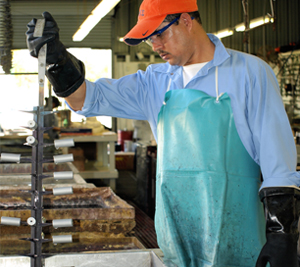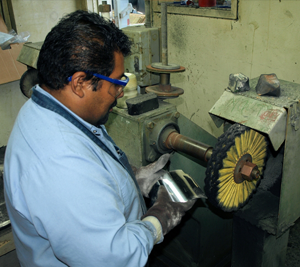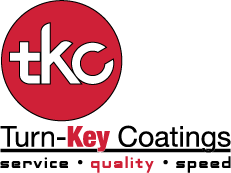Metal Plating Solutions to Meet Your Business Demands
Turn-Key Coatings is unique in that we offer a wide variety of plating processes as we strive to meet the most demanding and critical needs for metal plating and finishing. Click on a process to see the specific services offered. If you’re interested in a specific process not listed below, please contact us for more information.
Abrasive Blasting
(Grit Blasting, Sand Blasting, Bead Blasting)
Abrasive blasting is a cleaning process during which abrasives are propelled towards a surface at high-speeds. The abrasive media scrapes oxidation, burrs, flash and other unwanted particles from the metal, leaving the metal ready for further processing. The type of abrasive will vary with the delicacy of the items to be blasted, the desired surface finish, cosmetic appeal and extent of the material to be removed.
Abrasive blasting is used primarily in the following cleaning processes:
We stock Aluminum Oxide and Glass Bead media; however others are available upon request.
Acid Wash
(Pickling)
Acid Washing, etching or pickling, is a metal surface treatment used to remove impurities, such as stains, inorganic contaminants, rust or scale, from ferrous metals. A solution called pickle liquor, which contains strong acids, is used to remove the surface impurities. It is commonly used to descale or clean steel.
In a special application, steel is acid cleaned for dye penetrant inspection (DPI). Because surface impurities produced by mechanical finishing may smear some components of the steel, these can “hide” the surface defects intended to be revealed by the DPI. Acid etching or washing will remove these metallic impurities so the dye can reveal any surface defects.
Alodine
(Chemical Film)
Alodine and Iridite are registered trademarks for a process also known as Chromate Conversion. This is a chemical treatment process for aluminum which provides corrosion protection as well as surface preparation for paint and adhesives. Chromate is a superior treatment which enhances bonding ability, making it an excellent base for adhesives or paint. It is also used widely for electronics as it enhances corrosion resistance while remaining electrically conductive.

Hardcoat Anodizing
(Type III)
Anodizing is an electrochemical process producing a nonconductive, durable, industrial coating with excellent corrosion resistance which can be provided in a variety of colors. The surface of aluminum has a thin, natural occurring oxide coating. The electrochemical process of anodizing increases the thickness of this coating in order to resist abrasion and corrosion; the thicker the coating the greater the resistance.
Hardcoat or hard anodizing (Type III) is similar to standard anodizing (Type II) in that it also creates a film of aluminum oxide on the part. It is produced at colder temperatures and provides a surface that is harder, smoother, and more wear and corrosion resistant than standard anodizing.
Hardcoat finishes are typically darker in appearance than standard anodizing depending on the coating, thickness and alloy. A variety of colors are available on thinner coatings. Heavier coatings can be dyed black or some darker shades of color.
Standard Anodizing
(Type II)
Anodizing is an electrochemical process producing a nonconductive, durable, decorative coating with excellent corrosion resistance which can be provided in a variety of colors. The surface of aluminum has a thin, natural occurring oxide coating. The electrochemical process of anodizing increases the thickness of this coating in order to resist abrasion and corrosion; the thicker the coating the greater the resistance.
Parts can be dyed to produce beautiful finishes with a deep color that is far superior to a painted surface. Turn-Key Coatings offers a wide variety of colors including Black HBL, Green LWN, Blue G, Fiery Red ML, Gold S, Gold 4N, Grey BL, Violet 3D. Other colors are available on request.
Bright Acid Tin
Applied on ferrous or non-ferrous metals. Tin is a ductile metal often used to impart solderability and conductivity. It covers well but some substrates will react with the tin, forming non-solderable intermetallic layers, caused by migration of substrate components into the tin. Migration can often be minimized by undercoating with a layer of nickel or copper. Tin will not tarnish easily and is often used for decorative purposes.
Acid or Cyanide Copper
Applied on ferrous or non-ferrous metals. Copper is highly conductive and provides good solderability. It can be used as an underplate (or “strike”) which can aid in covering minor base metal surface imperfections. Copper is often used for undercoating, to lubricate (anti-galling), to prevent case hardening, to enable tinning, etc.
Because copper has excellent leveling properties and very high throwing efficiency, it makes an excellent undercoat for most other metals. In addition, because copper is ductile, it polishes easily to a high shine so that it supports a bright, shiny finishing metal above it.
Solid Film Lubricant
Solid film lubricants are coatings that contain very fine particles of a lubricant, such as Molybdenum disulfide, blended with a binder and other additives. The lubricant is sprayed, dipped or brushed onto a surface and once cured it creates a solid film which reduces friction and increases the wear life of the surface and some formulations also offer corrosion protection.
We stock the following solid films; however others are available upon request:
Electropolish
Electro-polishing is a process in which metal is caused to dissolve under tightly controlled conditions. As a result of this process the surface is very smooth and can be brought to a brilliant luster. In addition, it imparts new surface qualities to the part. The absence of scratches, strains, metal debris and embedded abrasive characterizes the electro-polished surface. The surface has the ‘true’ crystal structure of the metal, undistorted by the cold working associated with mechanical finishing methods.
Electropolishing can be thought of as the opposite of electroplating, with metal being removed from the surface as opposed to being deposited on the surface.
Etching
Because surface impurities produced by mechanical finishing may smear some components of the steel, these can “hide” the surface defects intended to be revealed by the DPI or LPI. Etching will remove these metallic impurities so the dye can reveal any surface defects.
Gold Plating
Applied on ferrous or non-ferrous metals. Used extensively for electronic contacts and connectors due to its conductive properties and the fact it does not tarnish. High purity gold coatings, as offered by Turn-Key Coatings, are preferable because impurities from lower purity gold can made soldering more difficult. The optimal deposit thickness range for soldering is between 0.00005 and 0.0001 inch.
Specialty or Custom Masking
Turn-Key Coatings employs skilled “artisans” who apply custom masking in exacting detail. Specialty or custom masking comes into play when only certain areas of a particular part are to be plated or anodized, or when multiple processes are required on the same part. For example, anodizing aluminum provides for durability but results in a nonconductive aluminum surface so to have conductive and corrosion resistant properties on a portion of the part it may have an alodine coating, also known as iridite or chromate conversion, applied. This is quite common. Another example is when a specific part has more than one plating process required such as nickel and gold plating on different portions of the same part.
Bright Nickel (Electrolytic Nickel)
Applied to ferrous or nonferrous metals. A hard, durable corrosion protection, nickel has both engineering and decorative applications. Nickel is commonly applied as a base layer for its leveling, smoothing, and barrier characteristics.
Electroless Nickel
Applied to ferrous or nonferrous metals. Durable corrosion protection which can cover into tight corners. Also used for decorative purposes. Offers good uniformity of deposit with excellent corrosion, wear, and abrasion resistance. It can be plated uniformly in recesses, blind holes and cavities, does not build up on edges, and has very high wear endurance. Has good ductility, lubricity (anti-galling), and electrical properties with high hardness.

Polishing
Polishing is an art form unto itself which can take years to master. When done correctly, mechanical polishing is also very labor intensive. Turn-Key Coatings employs skilled polishers that achieve miraculous results in meeting specific finishes for functional or decorative requirements. Polishing before anodizing will provide the finished parts with a very brilliant appearance that make standard anodizing colors come alive. A variety of decorative finishes are also available when special surface finish techniques are used in combination with our plating processes. Examples would include brushed and satin finishes with either gold or nickel plating.
Passivation (Types II, VI, VII, VII)
Passivation is the treatment of a stainless steel with a mild acid solution. It is intended to promote the formation of a thin transparent oxide film that will prevent any rust spotting.
This process removes free iron and other foreign matter imbedded in or smeared on the surface during machining, pressing, tumbling, lapping and abrasive blasting that if allowed to stay will produce rust spots on the stainless steel surface.
Manganese Phosphate
Phosphate coatings are applied to impart lubricity (anti-galling), wear and corrosion resistance, and as a base for paints, powder coating and corrosion inhibiting oils. Phosphates, by themselves give some corrosion resistance. This can be enhanced by applying corrosion inhibiting oils and waxes. They form a tightly adherent coating with the base metal and, because of their crystalline nature, make excellent bases for paints and other materials.
Manganese phosphate has better corrosion and wear resistance than zinc phosphate. It gives a higher coating weight than zinc phosphate.
Zinc Phosphate
Phosphates are applied to impart lubricity (anti-galling), wear and corrosion resistance, and as a base for paints, powder coating and corrosion inhibiting oils. Phosphates, by themselves give some corrosion resistance, but because of the crystalline nature of the coatings, they quickly absorb corrosion inhibiting oils and waxes. They form a tightly adherent coating with the base metal and, because of their crystalline nature, make excellent bases for paints and other materials.
Similar to Manganese phosphate, Zinc phosphate maybe slightly better anti-galling/lubricity characteristics. Less expensive than manganese.

Silver Plating
Applied on ferrous or non-ferrous metals. Offers a decorative finish, conductivity, corrosion resistance, and lubricity (anti-galling). Silver has excellent electrical conductivity. Silver is best suited for engineered applications requiring solderable surfaces, electrical contact characteristics, thermal conductivity, wear resistance of load-bearing surfaces, spectral reflectivity properties, electrical applications, and good corrosion resistance.
Zinc Plating
Applied on steel, Zinc plating is a soft, corrosion-resistant finish; decorative, ductile, marginally solderable and often used as a paint primer. Zinc is a sacrificial finish in that it will corrode before the base metal. Corrosion resistance is a function of thickness and can be enhanced by adding a conversion coating. Suitable for providing shelf life for parts and in less severe environmental applications.
Other Services
Other special services are available dependent upon the needs of our customers. We are constantly adding to the services we provide. If you do not see a particular service or metal finish listed in processes that you may need, please contact us through email or our toll free number. Turn-Key Coatings has a partnering approach to our business and we currently offer finished turn-key parts, assembly work, or fabrication through our extensive contacts with machining and sheet metal companies.


